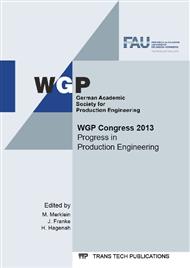p.157
p.165
p.173
p.181
p.189
p.197
p.205
p.213
p.221
Formability of an Anti-Fingerprint Coating Considering the Corrosion Behavior of the Stainless Steel Substrate
Abstract:
Ground and satin stainless steel surfaces are often applied to lend various products a characteristic high-quality appearance. Examples can be found in interior and exterior architecture, passenger elevators, public ticket machines and cover panels of white goods. In everyday use the visual appearance of these products is impaired by soiling. Especially on the surfaces of household appliances fingerprints tend to accumulate. On satin stainless steel parts the cutaneous sebum sticks to the brush marks. Thus extensive cleaning effort is required. Since several years the manufacturers of stainless steel offer satin stainless-steel sheet metal equipped with thin clear coatings for this application. The clear coating fills the brush marks and also causes a better wetting behavior and optimal cleaning properties. In this regard, the term easy-to-clean surface is common.The manufacturers face the challenge of applying a very thin clear coating with an index of refraction adjusted to the satin stainless steel surface and the cutaneous sebum. Thus, ideally the coating should not be distinguishable, concerning haptic and optic properties. The thickness of these coatings amounts to a few micrometers. Therefore, the heat transfer coefficient of the surface only varies minimally and the surface does not feel painted. The advantageous wetting behavior and the slightly differing reflection properties of the clear coating contribute to reducing the adhesion and conspicuousness of fingerprints significantly. Because of these attributes the term anti-fingerprint coatings is used.A further prerequisite for the application of anti-fingerprint coatings in high-quality parts is a good scratch resistance. Therefore, nanoparticle-reinforced coating systems are applied. Typically hard particles like SiO2 or Al2O3 are used. In addition to this, a curing procedure by ultraviolet radiation combined with a suitable solvent-free coating system can be used. This further improves the hardness and scratch resistance of the coating. Due to these requirements the clear coatings are applied in a coil-coating procedure. Consequently, the final painted sheets have to be processed to the respective sheet metal part. Common forming processes for white goods’ panels are bending and crash forming. After forming the final processor does not spend any effort on varnishing or curing on-site which leads to special cost savings in comparison to a piecework coating.The required performance characteristics of the anti-fingerprint coating allow no compromises concerning the coating system with regard to the formability. During forming operations damage is caused to the clear coating in the form of crack formation and delamination. Due to the optical properties of coating systems specifically adjusted to ground stainless steel surfaces, the defects in the clear coating are difficult to identify precisely. However, the properties of the final painted sheet metals’ surface are impaired. This also includes the corrosion resistance which must be taken into account especially for stainless steel applications, e.g. in the kitchen area or in outdoor applications.On the one hand this paper deals with experimental analyses for the identification of the defects caused to an anti-fingerprint clear coating by forming operations. The elaborated procedure is used to identify cracks and delamination due to bending operations. In the experiments mandrel bending specimens of the coated stainless steel sheet metal are formed. Due to different bending radii the intensity of cracks and delamination in the coating varies. But the orientation of the bending edge towards the grinding direction also influences the damage intensity and the damage characteristics. These specimens are also examined in a salt spray test to determine the influence of the different coating damages on the corrosion resistance of the stainless steel substrate. In comparison, the same stainless steel sheet metal material without clear coating is tested simultaneously. The comparison demonstrates the influence of the coating and the deformation-induced damages. On the other hand, to examine the damages as a result of a typical forming process a simplified oven panel is manufactured in a crash forming tool. The front side of the panel remains flat and shows no strains. But along the sharp bending radius, which is typical for the design of high-quality white goods’ applications, cracks in the clear coating can be observed. The experimental results show an influence on the coating damages resulting from the use of a deep draw foil. Furthermore, the forming tool features a heating device and panels are formed at higher temperatures with an effect on the coating damages.
Info:
Periodical:
Pages:
189-196
Citation:
Online since:
September 2013
Authors:
Price:
Сopyright:
© 2013 Trans Tech Publications Ltd. All Rights Reserved
Share:
Citation:


